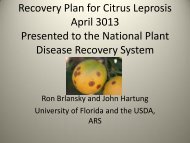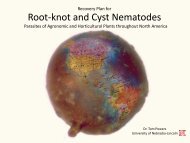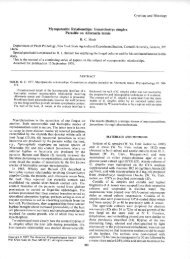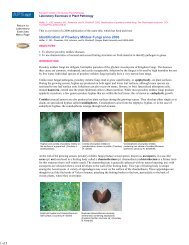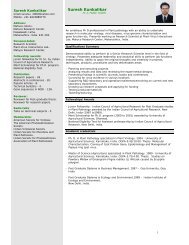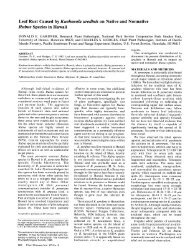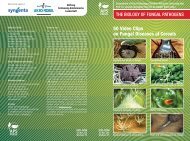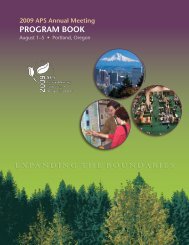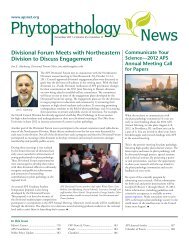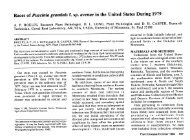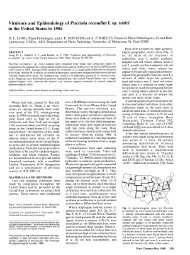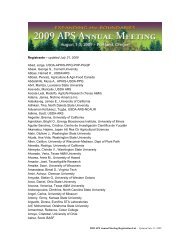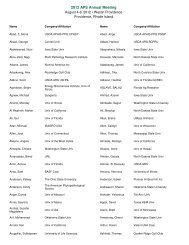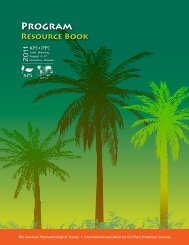view article - American Phytopathological Society
view article - American Phytopathological Society
view article - American Phytopathological Society
Create successful ePaper yourself
Turn your PDF publications into a flip-book with our unique Google optimized e-Paper software.
Homalodisca coagulata is a polyphagous leafhopper Onion seedlings which were grown in a greenhouse were inocuvector<br />
of many diseases induced by Xylella fastidiosa, lated with VAM fungi by placing inoculum on the entire root<br />
although little is known concerning factors that system after the seedlings had grown for different periods of<br />
influence feeding. H. coagulata, confined to stems of time. Seedling age had a great effect on mycorrhizal colonizahost<br />
plant species produced copious quantities (i-2 tion. VAM colonization took place rapidly in 3-day-old onion<br />
ml/h) of dilute exudate (8-25mM) consisting mainly of and reached 51% after one week. Older plants were far<br />
inorganic<br />
less<br />
ions, characteristic of a xylem fluid- responsive. VAM colonization of onion and pepper reached a<br />
feeder. Total amino acids, organic acids and sugars maximum two weeks after inoculation and of cotton at 3 weeks<br />
were metabolized with > 99% efficiency; major organic after inoculation. In the field, comparisons of VAM colonizacompounds<br />
(glutamine, asparagine, malic acid and tion efficiency with respect to placement of the inoculum were<br />
succinic acid) with > 99.9% efficiency. Biochemical studied. Inoculum was placed 3 cm below seeds at planting and<br />
and biophysical plant factors, and leafhopper also 5 cm deep by 3 cm from one side of the root system<br />
responses<br />
and 5<br />
were manipulated by altering plant nutrient cm deep by 3 cm from both sides of the root system 2 weeks<br />
status and moisture stress. Feeding was not reduced at after planting. Maximum VAM colonization was achieved when<br />
a specific threshold xylem fluid tension. inoculum was applied 3 cm below seeds at planting.<br />
23 27<br />
THE PRODUCTION OF A POLYCLONAL ANTISERA TO THE BEET LEAFHOPPER EFFECTS OF OZONE EXPOSURE AND SOIL WATER DEFICIT ON GROWTH,<br />
TRANSMITTED VIRESCENCE AGENT. D. A. Golino*, B. C. Kirkpatrick, ECIXJMYCORRHIZAE AND NON-STRUCTURAL CARBOHYDRATES OF LOBLOLLY<br />
and G. A. Fisher. USDA-ARS*, Department of Plant Pathology, PINE SEEDLINGS. S. Meier and L. F. Grand, Department of Plant<br />
University of California, Davis, CA 95616. Pathology, North Carolina State University, Raleigh 27695.<br />
Antisera specific for the beet leafhopper transmitted virescence<br />
ntiseagsecific agent (BLTVA-MLO) fo webtlfoere were prepared byvinjectingrabbir- by transpited injecting rabbits<br />
with MLO-enriched extracts prepared from infected leafhoppers,<br />
Circulifer tenellus (Baker). When used in a F(ab)2/Protein A<br />
ELISA system thisantisera reacted positively with roots and<br />
leaves of symptomatic BLTVA-infected periwinkle (Catharanthus<br />
roseus), but not with periwinkles infected with Spiroplasma<br />
citri, X-disease or three strains of western aster yellows,<br />
ELISA also detected the BLTVA-MLO in infected radish (Raphinus<br />
sativus) and plantain (Plantago major). Western blot analysis<br />
of soluble proteins from BLTVA-MLO-infected periwinkle and C.<br />
tenellus revealed a single dominant antigen of approximately<br />
40 kd.<br />
Loblolly pine (Pinus taeda) seedlings from three full-sib<br />
d/week families<br />
for were<br />
6 or<br />
exposed<br />
12 wk).<br />
to<br />
Soil<br />
0, 50,<br />
water<br />
100,<br />
potential<br />
or 150 ppb<br />
was<br />
ozone<br />
maintained<br />
(5 h/d, 5<br />
near pot capacity (-0.03 MPa) or soil was allowed to dry to<br />
approximately -1.0 MPa and resaturated. Exposure to ozone and<br />
soil water deficit each resulted in less seedling volume growth<br />
and total dry weight. Exposure to increasing ozone<br />
concentrations resulted in a linear reduction in foliar starch<br />
but did not affect hexose or sucrose production. Soil water<br />
deficit lessened starch and sugar content in above- and below-<br />
ground plant parts. Soil water deficit did not affect numbers<br />
of ectomycorrhizal tips or percentages of roots that formed<br />
ectomycorrhizae. A linear dose-relationship between ozone and<br />
ectomycorrhizae was observed. The number of ectomycorrhizal<br />
24<br />
tips/cm long root and the percentage of feeder roots that formed<br />
ectomycorrhizae were lower as ozone concentration increased.<br />
PHYLOGENETIC RELATIONSHIPS OF THE WESTERN X-DISEASE MYCOPLASMA-<br />
LIKE ORGANISM (X-MLO) AS ESTABLISHED BY 16S rRNA SEQUENCE. 28<br />
B. C. Kirkpatrick and J. D. Fraser. Department of Plant<br />
Pathology, University of California, Davis, CA 95616. CHARACTERIZATION OF PROTEIN/ISOZYME PATTERN$ IN A<br />
TRIPARTITE SYMBIOSIS. J. S. Neck, J. B. Szerszen, and R. A. Taber,<br />
Two cloned DNA fragments, which together contain 97% of the X- Department of Plant Pathology and Microbiology, Agricultural<br />
MLO 16S ribosomal RNA gene (rRNA), were sequenced. One cloned Experiment Station, Texas A&M University, College Station 77843.<br />
fragment contains two putative promoters that are very similar<br />
to the 16S rRNA promoters of Bacillus subtilis, and 673 bp of Cosymbionts, Arachis hypogaea L. cv. Tamnut, Bradyrhizobium spp. (3<br />
the 5' end of the 16S rRNA. The second cloned fragment con- strain mixture), and Glomus etunicatum Becker and Gerd. were grown in<br />
tains 796 bp of the 3' end of the 16S rRNA gene. The G+C all combinations to assess potential plant (peanut) metabolic responses to<br />
content of the 16S rRNA gene is 45.5%, while the 5' flanking colonization by the rhizobial and vesicular arbuscular mycorrhizal<br />
sequence is 23%. These G+C values are among the lowest re- (fungal) components. Extractable host leaf/root tissue (50 day old plants)<br />
ported for prokaryotes. The X-MLO 16S rRNA gene is 78% homo- samples and pure culture rhizobial and fungal spore samples were<br />
logous to the 16S rRNA genes of B. subtilus and Mycoplasma electrophoretically (IEF-PAGE) separated and stained for buffer soluble<br />
capricolum, and 73% homologous to E. coli. These results general protein, glycoprotein, and isozyme patterns. Preliminary results<br />
suggest that the X-MLO is phylogenetically related to, but indicate some symbiotic combinations showed differential band patterns<br />
distinct from, other gram-positive prokaryotes. and/or band intensities.<br />
25 29<br />
CLONING AND SEQUENCE ANALYSIS OF THE 16S RIBOSOMAL RNA GENE OF PRODUCTION OF VA MYCORRHIZAL SPORES IN A SAND-VERMICULITE<br />
WESTERN ASTER YELLOWS MLO (AY-MLO). C. R. Kuske and B. C. MEDIUM. H. D. Liyanage and N. C. Schenck, Department of Plant<br />
Kirkpatrick, Department of Plant Pathology, University of Pathology, University of Florida, Gainesville, FL 32611.<br />
California, Davis, CA 95616.<br />
A 0.1 strength Long Ashton (nitrate type) nutrient solution of<br />
The 16S ribosomal RNA gene (16S rDNA) of the AY-MLO was identi- varying P levels (0.05 to 20 mg P/l) was evaluated in a sandfied<br />
by Southern blot analyses, using cloned fragments of the vermiculite (3:1, v/v) mixture as a substitute for a soil pot<br />
Western X-NLO 16S rDNA as heterologous probes. A 1.5 kbp Eco- culture medium. Two species of VA mycorrhizal fungi, Glomus<br />
RI/HindIII fragment, unique to AY-MLO DNA, hybridized with a etunicatum (isolate LETC 329) and G. mosseae (isolate LNSS 336)<br />
probe containing the 3' region of the X-MLO 16S rDNA. Two AY- were evaluated on alfalfa, bahiagrass and onion; in addition<br />
MLO-specific fragments (2.5 and 1.0 kbp) hybridized with a LETC 329 was evaluated on wheat. Colonized root lengths were<br />
probe containing the 5, end and upstream flanking sequences of maximum at 2 ag P/l for G. etunicatum and C. mosseae at 12 and<br />
the X-MLO 16S rDNA. The 2.5 kbp and 1.5 kbp fragments were 15 weeks, respectively. Increasing levels of P caused a more<br />
cloned in Ml3mp vectors and sequenced. The 2.5 kbp fragment rapid decline in root colonization by 0. etunicatum than by G.<br />
contains about 670 bp of the 5' region of the 16S rDNA and a- mosseae. At 0.5 mg P/l,_0. etunicatum--produced maximum spore<br />
bout 1.9 kbp of A:T rich DNA upstream. The 1.5 kbp fragment numbers per plant (39,500-43,400) on all hosts except wheat.<br />
contains 863 bp of the 3' region of the 16S rDNA, followed by a Glomus mosseae produced maximum spores on alfalfa and bahiagrass<br />
spacer region containing a tRNA gene and the 5' end of the 23S (990 and 4800) at 0.5 mg P/l and on onion (1381) at 10 mg P/l.<br />
rDNA. Sequence comparisons with the 16S rDNA of other pro- Thus, sand -vermiculite was an effective pot culture medium for<br />
karyotes and plant organelles indicate the AY-MLO is most close- these two species of VA mycorrhizal fungi.<br />
ly related to ~ci subtilis and Myc~opla.sma. ca~pric~oluma.<br />
30<br />
26 ACRONYMS FOR SPECIES OF VA MYCORRHIZAL FUNGI. Y. P~rez and<br />
N.C. Schenok, Plant Pathology Dept., Univ. of Florida, Gainesville, FL 32611.<br />
THE EFFECT OF ROOT AGE AND POSITION OF MYCORRHIZAL INOCULUM ON<br />
COLONIZATION OF COTTON, ONION AND PEPPER. U. Afek, E. A unique four-letter acronym for each species is proposed which can be<br />
Rinaldelli, d. A. Menge and E. L. V. Johnson. De-pt. of Plant used in lieu of epithets in computer databases, publication graphics, and<br />
Pathology, Univ. of California, Riverside, CA 92521. experimental notations. Other abbreviations occur in the literature, but the<br />
1138 PHYTOPATHOLOGY



